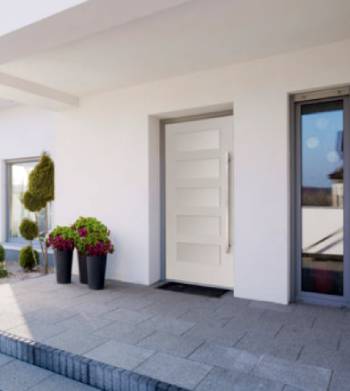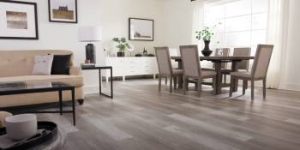Trimlite doors are rapidly becoming a go-to choice for homeowners and builders seeking stylish, reliable, and affordable interior and exterior door solutions.
In this in-depth review, we’ll examine the pros and cons of Trimlite doors, explore their unique features, and address some frequently asked questions.
The Pros of Trimlite Doors

- Affordability and Versatility
One of the first pros of Trimlite doors is their affordability. They offer high-quality doors without breaking the bank, a feature that is sure to appeal to budget-conscious consumers. What’s more, Trimlite doors come in a variety of styles and designs to match any home decor, making them a versatile option for many homeowners.
- Durability and Quality
When it comes to quality and durability, Trimlite doors don’t disappoint. Manufactured from molded composite Medium-Density Fibreboard (MDF), these doors are built to withstand the rigors of everyday use. The MDF construction ensures they resist warping and cracking, guaranteeing a long lifespan.
- Aesthetics
Trimlite’s design variety extends to both modern and traditional styles. Whether it’s a rustic barn door or a contemporary glass panel door, Trimlite ensures that every design is visually appealing, adding to the overall aesthetic of any home..
Read More: About Window World Sliding Glass Door
The Cons of Trimlite Doors

- Limited Customizability
While Trimlite doors offer a range of design options, they might fall short for those seeking extensive customizability. For homeowners with highly specific design requirements, this could be a drawback.
- Potential for Damage
While MDF is a durable material, it can be prone to damage if exposed to water over extended periods. This makes Trimlite doors potentially less suitable for areas prone to dampness or high humidity.
FAQ: Everything You Need to Know About Trimlite Doors
Trimlite doors are manufactured in the United States. The company prides itself on providing quality, American-made products for homeowners and builders.
Trimlite doors are primarily made of molded composite MDF, a strong and versatile material known for its durability and resistance to warping.
Molded composite MDF, or Medium-Density Fibreboard, is an engineered wood product. It’s made by breaking down hardwood or softwood residuals into wood fibers, combining these with wax and a resin binder, and pressing the mixture under high temperature and pressure.
An MDF interior door is a door constructed from Medium-Density Fibreboard. This material gives the door a smooth finish, making it perfect for painting, while also offering excellent durability.
The best type of composite door depends on individual needs and preferences. Trimlite’s MDF doors are highly popular due to their strength, affordability, and design versatility, making them a strong contender.
The terms MDF and composite are often used interchangeably in the context of doors. MDF is a type of composite material, so when comparing MDF to composite, it’s like comparing apples to apples. The choice between different types of composite materials, like MDF versus particle board, depends on specific use cases and preferences.
Read More: About Simonton Inovo Patio Door
The Final Verdict
In the final analysis, Trimlite doors offer an impressive combination of quality, durability, and affordability. The minor cons identified shouldn’t detract from the overall value proposition of these doors, particularly for those seeking a balance of style, reliability, and cost-effectiveness. As always, the final choice should align with individual needs, preferences, and budget constraints. With this review at hand, you are now equipped to make an informed decision about whether Trimlite doors are the right fit for your home.
The Trimlite Difference
At the core of Trimlite’s success is its focus on providing a broad array of door styles, coupled with a commitment to quality and customer satisfaction. The company’s range of MDF doors are designed to suit varying tastes and interior decor schemes, adding a touch of elegance and sophistication to any home.
Whether you’re embarking on a remodeling project or building a new home from scratch, Trimlite doors are definitely worth considering. Their value for money, durability, and appealing aesthetics make them a solid choice in a crowded market.
A Closer Look at MDF
To appreciate the benefits of Trimlite doors, it’s essential to understand the value of MDF. This material has revolutionized the door manufacturing industry with its versatility and performance. Molded composite MDF, the material at the heart of Trimlite doors, ensures that the doors are resistant to temperature changes and humidity — essential factors for longevity.
Moreover, the smooth surface of MDF is perfect for painting, allowing homeowners to customize their Trimlite doors in any color that suits their interior decor. While it’s true that MDF may be vulnerable to damage in damp conditions, with proper care and maintenance, this shouldn’t pose a significant problem.
It’s All in the Details
What sets Trimlite doors apart is their attention to detail. Each door is carefully crafted to ensure a perfect blend of functionality and aesthetic appeal. With options ranging from classic designs to contemporary styles, Trimlite doors can bring a touch of class and elegance to any home.
Making the Right Choice
Choosing the right door for your home is a significant decision. It’s not just about picking a door that looks good; it’s also about choosing a door that will stand the test of time, deliver value for money, and enhance the overall appeal of your home. With their blend of affordability, durability, and aesthetic appeal, Trimlite doors tick all these boxes.
In Conclusion
In summary, Trimlite doors offer a compelling blend of affordability, style, and durability. While there are some minor cons, these are far outweighed by the numerous pros. Whether you’re a homeowner seeking to refresh your interior decor or a builder in search of reliable, quality doors, Trimlite doors could be just what you need.
Remember, the ultimate decision should align with your specific needs and preferences. Consider your home’s design aesthetics, your budget, and the kind of longevity you expect from your doors before making a choice. Armed with this review and your personal considerations, you are now well-positioned to make an informed decision.
Choose wisely, and remember, a door is more than just an entryway — it’s an integral part of your home’s personality and charm.



